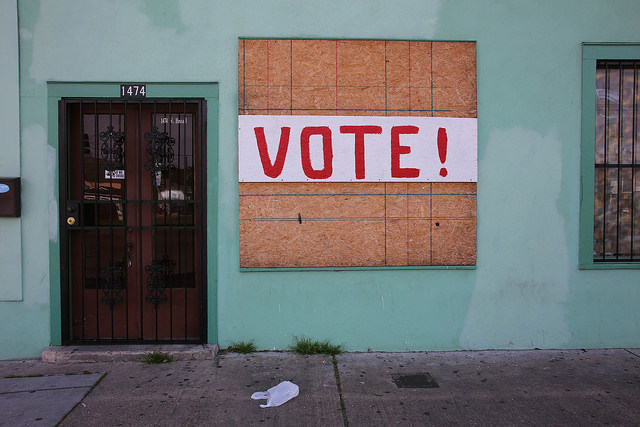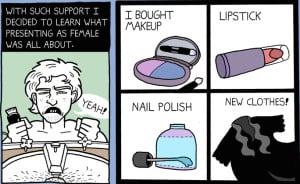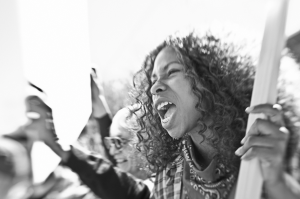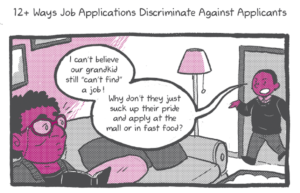I still remember the day Hillary Clinton announced she was running for President of the United States. My eyes were glued to CNN; I watched her announcement over and over again, awed by the diversity and excitement surrounding it.
I don’t intend for my writing to come off as, “I backed Hillary because she’s a woman.” That’s definitely not how I roll. I’m a Black woman before I’m anything else and try to vote in a way that supports me and my people.
Originally, I was gunning for Bernie. After he allowed Black Lives Matter activists to speak at a rally, I was hooked. But, much of the country felt otherwise.
When Bernie didn’t end up becoming the Democratic presidential candidate, I did what I had to do to keep a white supremacist out of the office.
Like many others, I thought Clinton’s journey to the White House would be a cakewalk. After all, she was a Clinton—a career politician. She certainly wasn’t perfect, but she was poised and appeared to be for the people—at least more so than her Republican opponent who represented sexism, racism and Islamophobia among other things. I hoped that would be enough for her to clinch the White House.
Then, Nov. 8, 2016, happened. From the beginning, the results were too close for comfort. Clinton and Trump were constantly neck and neck. At one point, a friend remarked:“What if he actually wins this thing?”
Around midnight, CNN, MSNBC and Fox were all announcing Donald Trump as the president-elect. My stomach was in knots, my head foggy. It felt like the beginning of the end, and I wasn’t alone in that feeling. Immediately, there were calls to resist Trump.
But what now? It’s been over a year since Trump was elected and still, we are consistently hit with shocking and harrowing news related to his governing every single day.
While marches and protests are a great show of solidarity for marginalized individuals who have been and will continue to be the most at risk under the current administration, we must mobilize in more powerful ways in order to ensure this administration’s hopes do not become a reality.
We know that there is much work to do in the next seven months until midterms to make sure that everyone is heading to the polls and gutting Congress of all those who have been complicit in Trump’s xenophobic, homophobic and racist policies.
There’s no question—the work has to be done. There is too much at stake.
Here are five things you can do ASAP to get ready for special elections in your state and the midterm elections in November.
1. Register to Vote
This seems like an obvious one, but in every state except North Dakota, citizens have to register to vote before an actual election takes place.
If you fail to register to vote by the indicated time in your state or county, you will not be able to vote in your community’s upcoming election. To see if you are registered to vote, visit vote.org, type in your information and you’ll receive your results in seconds.
You can register at your local DMV, armed services recruitment center or a state and county public assistance office (these are SNAP/food stamps, WIC offices).
In 38 states, citizens can register to vote online. Make sure you are registered by the noted deadline to participate in this years election.
It is most imperative to vote if you live in the states where Trump barely won—Alaska, Florida, Maine. Get out to vote in the November primaries as well. The races will be close and could go either way!
2. Attend a local government meeting.
There has been a large focus on the White House and movers and shakers in Washington D.C., but remain mindful of the local elected officials in your town.
Are your representatives diverse? Do they reflect the community they are serving? Do potholes go months without getting filled? Are local elementary schools still using the same textbooks as when you attended?
The president doesn’t have direct control of any of these issues, so while it’s important to be engaged at the federal level, it is equally important to be engaged at the local level.
Most local communities have recurring meetings that are open to the public. There, citizens can express their concerns, lobby for or against new construction in the area and listen to the plans elected officials have for the community.
In Sacramento, Calif., after two police officers shot unarmed Black man Stephon Clark, dozens of Black community members went to the next city council meeting to urge politicians to do something.
Thanks to the pressure from those folks, the city is now building a community center in the neighborhood where Clark was shot in the hopes that it might serve as a safe space for children and young adults.
In addition, the city’s police department immediately changed their body camera policy, making it mandatory that police announce when they are muting their body camera mics with an explanation.
We can make large changes locally. But if you can’t make it to a local governmental meeting, read the minutes and reports that most cities are required by law to make public. All of the information you need will be on your city’s website.
3. Understand what type of identification you will need to vote.
In 33 states, a valid photo ID is required in order to vote. Half of those 33 states are considered to have a strict photo ID law on the books. This means only a driver’s license, passport or valid military ID will do.
None of these forms of identification are necessarily easy to get, so you’ll want to make sure you give yourself plenty of time to secure a proper photo ID if you reside in a state that requires it.
Generally, photo ID requirements disproportionately affect people of color and low-income families. Government office hours, materials needed to secure a photo ID and the high cost of ID forms such as passports often make it difficult for these communities to secure the identification they’re needing in an easy and convenient way.
Additionally, many offices are only open on specific days and not past certain hours. Therefore, a single mother working two jobs to make ends meet who only has time to grab her kids in between shifts may struggle to make it to a government office to ensure she has the proper ID.
4. Research the candidates on the ballot.
By now, you’ve seen the signs and town hall meetings being posted for local and federal officials seeking election. So, go to them.
Go to their town halls and hear about their platforms, ask them specific questions that affect you and your loved ones directly and check out their voting history and stances. Voting is important, but make sure it’s an educated one.
In Indiana, Democratic Senator Joe Donnelly is up for re-election. Donnelly is known for his bipartisan voting and working across the aisles, which is why his seat may be hard to keep in November.
Both candidates running against him are Republicans. Three Republican-held seats are up for grabs in North Carolina and although they’re in districts that Trump won, it was a close race. In Ohio, former presidential candidate John Kasich’s governor seat will be up for grabs.
Former Obama Consumer Financial Protection Bureau head Richard Cordray hopes to take Kasich’s spot. Popular Republican rep Steve Chabot of Cincinnati is hoping to keep his seat as well—which will be critical for the GOP in a swing state like Ohio. To see the hot candidates in your state, check out CNN’s guide to midterm elections.
To flip the House of Representatives, Democrats will need to win 24 more seats. In the Senate, they need to flip 28 seats. Hot topics to be aware of are gun control, health insurance and immigration.
Voting for the wrong candidate could mean legislation is passed that negatively affects you and your loved ones.
5. Run for something
If the process of getting prepared to vote in November 2016 has frustrated you or the pool of available candidates is disappointing, why not run for something?
If you don’t know where to start, an organization called Run For Something (RFS) encourages, supports and (in some cases) funds diverse progressive candidates under the age of 35, and is helping many first-timers make their dream a reality.
The hope is that these candidates and elections might create a funnel of progressive candidates who then become career politicians and can pass progressive legislation benefiting the country’s most marginalized. In April, two candidates backed by RFS won their elections.
So far, the country has been on fire with electing progressive candidates. In Alabama, Democrat Senator Doug Jones beat out a Republican for the first time in 25 years. In Virginia, Ralph Northam won the governor’s race and in N.J.’s Phil Murphy defeated former presidential candidate Chris Christie to become N.J.’s governor.
Democrats have also been able to win close mayoral races in Charlotte, N.C. and St. Petersburg, Fla., states that went to Trump in the 2016 election.
These unexpected wins increase the chances that more progressive policies will continue to be protected—even with Trump in office.
The only way this trend will continue? Run for something, register, and get out and vote in November!
[do_widget id=’text-101′]
Brittany is an independent journalist located in the Midwest where she covers race, gender and politics for national publications. Formerly, she managed social media for brands like Hershey and Anheuser Busch and covered diversity and inclusion issues for higher ed institutions. Currently, she’s a business reporter for the Indianapolis Recorder and a copy editor for FoodBeforeLove.com.
Search our 3000+ articles!
Read our articles about:
Our online racial justice training
Used by hundreds of universities, non-profits, and businesses.
Click to learn more





















